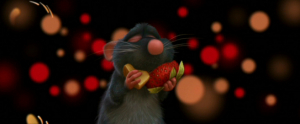
Brad Bird and Jan Pinkava’s 2007 animated family film Ratatouille follows the journey of a rat named Remy who has a dream of becoming a chef.[1] Like most family films, Ratatouille has an underlying moral message it aims to teach its audience. Ratatouille wants its audience to go away from the film with the idea that individuality is a good thing and that anyone can achieve something if they truly want and work for it. However, the anthropomorphising of Remy undermines this moral message as Remy has to act differently in order to be taken seriously or even considered at all. The film is supposed to follow an uplifting story about a rat who overcomes stereotypes to achieve his dream of becoming a chef but Remy was never portrayed as a stereotypical rat to begin with. By anthropomorphising Remy, Bird and Pinkava have separated him from the stereotypical rat. They made him walk on two feet rather than four because he doesn’t like getting his paws dirty, they made him like to enjoy the taste of his food rather than just eat whatever is there and they also made him want to spend his time cooking food and combining flavours rather than rooting through rubbish bins for scraps like his family. Remy only gets acceptance into the human world because he acts like a human rather than a rat. Rather than suggesting that anyone can achieve anything if they work for it, this film seems to say you can achieve things if you’re willing to act differently.
This is highlighted in the end of the film when Remy has found success in the human world and he and his human friend Linguini have their own restaurant in Paris. The scene starts with Remy and all of his rat family sat down at tables like they are in the restaurant but then a bell rings and Remy pushes aside some leaves and we see that the rats are not actually all sat in the restaurant but rather they are segregated from the humans and hidden in a place that is well out of their sight. The shrubbery Remy looks through serves as a boundary between the ‘us’ and ‘them’ of the human-rat relationship. Remy is the only one that is allowed to pass through that boundary because he is a combination of both human and rat, his appearance is that of the stereotypical rat but his characteristics are inherently human. Remy has access to the human world because he acts more like a human than a rat so acceptance is a result of his rejection of his animalism. The words of Gusteau’s mantra ‘any one can cook’ echo through the film’s moral message yet they rely on a presupposed notion of equality that does not exist. In order to cook Remy has to act in a way that will allow him to be accepted, he can’t just be anyone, he has to be a specific someone and in this film that someone is an anthropomorphised rat.
[1] Ratatouille. Dir. Brad Bird and Jan Pinkava. Buena Vista Pictures Distribution. (2007).
Bibliography
Ratatouille. Dir. Brad Bird and Jan Pinkava. Buena Vista Pictures Distribution. (2007).
Further Reading
Ratatouille, Projected Realities, (2014) https://projectedrealities.wordpress.com/2014/01/21/movie-review-ratatouille/
Chakraborty, Poushali, ‘Cooking as performance: Negotiating art and authenticity in Ratatouille’, Rupkatha Journal on Interdisciplinary Studies in Humanities, Vol.5(2), (2013)